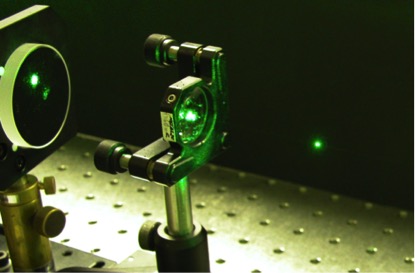
Optical trapping and manipulation of light-absorbing particles. The particle is visible as bright spot localized in the focal area of the singular beam
A research team that includes physicists from Texas A&M University at Qatar has taken the “fiction” out of “science fiction.”
Laser physicist Dr. Wieslaw Krolikowski, a professor in the Science Program at Texas A&M at Qatar, and his research team in Qatar and at Australian National University (ANU) have moved small glass spheres with a laser beam — much like a tractor beam sci-fi fans have become accustomed to seeing on movie and television screens. The work is published in Nature Photonics.
The team covered small glass spheres, about 50 micrometers in diameter, with a thin gold coating to absorb light. A coated sphere was then placed in a special hollow-beam laser in which a circle of light surrounds a dark center. The sphere sat in the dark center of the beam. Interaction with the light edges of the beam causes the sphere to absorb energy from the laser beam through the special, thin gold layer coating the sphere, raising the temperature and changing the air pressure surrounding the sphere. This change in temperature pushes the sphere either toward or away from the laser.
“When we produced light to heat the backside of the sphere,” Krolikowski said, “the higher air pressure at the back of the sphere pushed it towards the light. The opposite occurred when we heated the front of the sphere.”
This tractor-beam effect had previously only been observed on the microscopic level using plastic beads that only moved a few nanometers, Krolikowski said. But the Texas A&M at Qatar—ANU research team has managed to move particles up to 20 centimeters.
Krolikowski said that this success has potential in the real world, not just Hollywood. In medicine, doctors can use x-ray analysis of viruses and biological specimens. This requires delivering a particle to a very specific spatial location where the laser light will be focused.
Another possible application is to use this tractor beam to capture and move particles produced in an experimental chamber into a special area for analysis.
“Nanotechnology is a big deal these days,” Krolikowski said, “but very often many of these nanoparticles are produced from carcinogenic materials such as arsenic, so we don’t want to touch it. So light could provide the ability to manipulate particles into a specific location for analysis.”
Krolikowski joined the Texas A&M at Qatar faculty in January 2014 and is an expert in nonlinear optics, having worked in the field for more than 30 years. His area of research is in shaping a light beam so that it deposits energy in small, precise locations. He is in the process of setting up his new laser laboratory in the Texas A&M Engineering Building on the Education City campus.